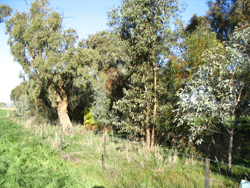4.2.1.7 - What are my catchment obligations?
Return to Main Menu | Return to Step 4 | Return to Step 4.2.1 | Next Step
Page top
A local government planning permit is not normally required for a centre pivot, but is required for associated earthworks or clearing of remnant native vegetation. This step discusses issues particularly relevant to centre pivot irrigation development. For further information, see Step 2.2.11.
|
 Offset plantings may be needed to compensate for trees removed |
- Earthworks – A local government planning permit is required for earthworks to ensure that regional drainage is not restricted or significantly changed by the proposed works, potentially impacting upon others.
- To avoid having to apply for a planning permit every time you want to implement a component of your Whole Farm Plan, your council can certify the plan, and you can implement it over several years. For more information, contact your local DPI office.
- An irrigation storage must comply with the farm dams legislation. Typically, you can have a drainage reuse storage of up to one megalitre of storage capacity for each 10 ha of irrigated land. If you want to store more than this, you need to provide water entitlement, either by purchasing water or by transferring some of your existing water entitlement. For more information, contact your local Rural Water Authority office.


